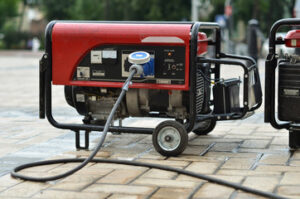Whether you need to power your home or office, a generator will keep things running in an emergency. They come in various sizes to fit different needs and are fueled by petrol, natural gas, or diesel.
Guys Generators have a stationary component known as the stator, and a rotating component called the rotor. It creates a magnetic field that changes direction with each shaft rotation, producing alternating current (AC).

Whether at your house, in an automobile, or at a nuclear power plant, a generator is an essential tool for supplying electrical power during a power outage. A generator converts mechanical energy into electrical energy using a mechanism that produces magnetic fields to induce currents in copper wires. These currents then flow through an external circuit to produce electricity. At the same time, there are different types of generators, most of which function similarly. The basic components of a generator are an engine, a rotor, and coils. Depending on the type of generator, other parts include a control panel, voltage regulator, and fuel combustion system.
The most common source of mechanical energy for a generator is an internal combustion engine. While large generators use steam or combustion gases, small units utilize water, wind, or hydraulic turbines to create mechanical energy. The mechanical energy these sources produce is transferred to the generator by a rotating shaft. The shaft spins a spinning electromagnet (armature) inside a stationary magnetic field (stator). The armature generates electricity by forcing electrons through copper wiring.
When the rotor first starts to rotate, it draws a small amount of current from the field coils because of their remanent magnetism. Once the rotor is spinning constantly, the current drawn from the field coils is larger, and the generator begins producing electricity. This process, known as self-excitation, is repeated repeatedly until the generator reaches a steady state power output.
A generator works based on the principle of electromagnetic induction discovered by Michael Faraday in 1831. Faraday found that the flow of electric charges could be induced by moving an electrical conductor through a magnetic field. When the rotor rotates, it creates a magnetic field around the windings of the armature. This magnetic field induces current in the armature’s copper wires, which flow through an external electrical circuit to supply electricity.
A generator is an efficient machine that turns gasoline, solar energy, or diesel fuel into usable electricity for commercial, residential, and industrial uses. It is important to understand how a generator works to make the right choice when selecting one for your home or business.
A generator is an invaluable equipment for businesses during emergency power outages. It can keep food from spoiling in refrigerators and freezers, prevent water damage to buildings and contents by keeping plumbing systems running, and maintain vital medical equipment like ventilators. In addition, it can communicate to customers that you are prepared for any situation and can meet their needs.
A power generator requires regular maintenance to ensure proper operation and longevity. This includes routine inspections of the generator, testing of the battery and transfer switch, and refueling. Additionally, the generator should be exercised once a month for 30 minutes, with the engine loaded to one-third of its nameplate rating. This practice helps prevent premature wear, thwarts oxidation of electrical connections, and keeps the generator ready to start when needed.
The generator’s spark plugs and air filter need to be changed regularly, as well. An old air filter can allow dirt to enter the combustion chamber, leading to premature wearing and failure. A new spark plug can help the engine run more efficiently, and it is relatively inexpensive compared to an oil change. It is recommended to change both the spark plug and air filter at least once a year.
A cooling system is also important for a generator, as it helps to draw out the heat that builds up during operation. In addition, a ventilation system is necessary to direct and remove the exhaust fumes generated during use.
Another crucial step is to inspect the generator for any signs of damage or leaks. It is also a good idea to clean the generator’s exterior and interior regularly. This will make it easier to spot any problems and repairs when the time comes.
Finally, it is recommended to write down all fluid levels, inspection results, and test results in a maintenance log for the generator. This can be used to compare the results of future tests and detect any issues that may arise. A maintenance log will also help you remember to perform the necessary maintenance and repairs.
A generator converts mechanical energy into electrical power to run appliances and lights during a power outage. They can be powered by gasoline, propane gas, natural gas, or diesel fuel. Portable generators are easy to use and offer an affordable alternative to expensive standby generators. They are ideal for home backup, recreational activities like picnics and camping, or professional applications such as food trucks or construction work. They are also an excellent option for avoiding the inconvenience of utility service interruptions caused by storms, wind, or snow.
Before using a generator, assess your power needs and follow all recommended safety procedures. In addition, if you are plugging in electrical appliances, ensure the generator is big enough to handle their total wattage requirement (found on the packaging). If you need to use extension cords with your generator, always choose ones that are heavy-duty and rated for exterior use. You should also check that the cords match the circuit breaker of the generator outlet; an accidental overload could result in electrocution.
If you’re using a portable generator, keep it out of the rain. Operating it in the pouring rain can cause electrocution or damage the engine. Some people have gotten creative and built cobbled-together shelters to protect their generators from the elements. However, these shelters may be unsafe to operate in high winds and should only be used in a well-ventilated outdoor area. It’s also important to note that the exhaust from a running generator can produce deadly carbon monoxide, so it must be kept at least 20 feet away from your house.
Alternatively, you can buy a transfer switch that is manually controlled to turn on your generator. This method is the safest because you can avoid backfeeding, which occurs when the generator sends electricity through the home’s wiring and into the distribution line. This is dangerous for utility workers, and it’s illegal in some jurisdictions.
Portable generators are a convenient and affordable way to provide temporary power for your home during a power outage. Depending on the size and capacity of your generator, you can power essential items such as refrigerators and sump pumps. A small generator is also ideal for recreational activities like camping and tailgating. However, if you plan to use your generator longer, consider investing in a permanent solution.
When used properly, a generator is safe and can provide reliable power during an emergency. However, improper use of generators can lead to various dangerous situations. These include electrical fires and carbon monoxide poisoning. In addition, some generators can back feed electricity into the grid and injure utility workers trying to restore power. These hazards are primarily caused by improper connections or fueling.
It is important to follow the manufacturer’s instructions when using a generator. In particular, never run a generator indoors or in partially enclosed spaces like garages. The exhaust produced by a generator contains carbon monoxide, a colorless, odorless gas that can kill people in minutes. It is also necessary to use battery-operated carbon monoxide detectors inside your home while the generator is running.
If you plan on using a generator for long periods, it’s best to alternate the usage of different appliances. This will prevent overloading and overheating of the generator. In addition, it is advisable to store the generator outside and away from heat sources. This will help ensure the engine is cooled and lubricated adequately to prolong its lifespan.
Always read the Owner’s Manual for your generator before operating it. The manual should include warnings and safety tips for proper operation. If you are unsure how to use your generator safely, consult an expert.
If a generator is being run inside your home, a transfer switch should be installed before the unit is used. A transfer switch electrically isolates generator circuits from the home and prevents the generation of deadly back feeding. This device will also prevent utility power from flowing into the generator and injuring or electrocuting utility workers.
If you cannot afford a transfer switch, it is still possible to run a generator safely by plugging appliances into the generator via heavy-duty extension cords. The cords should be rated for the wattage of the devices you plug into them. It is also a good idea to ensure that the cords are plugged into an outlet that is insulated and protected from water. This will prevent them from becoming tripped or exposed to moisture, which can cause short circuits.
